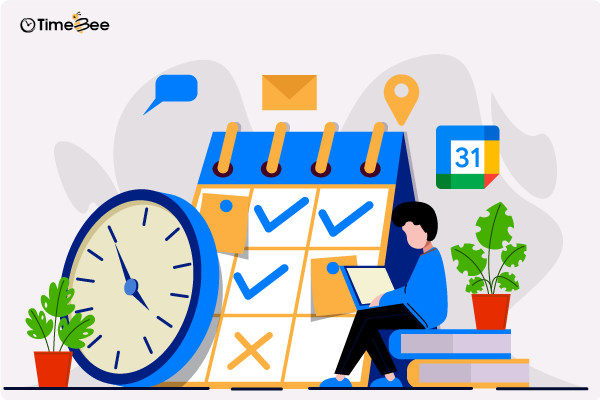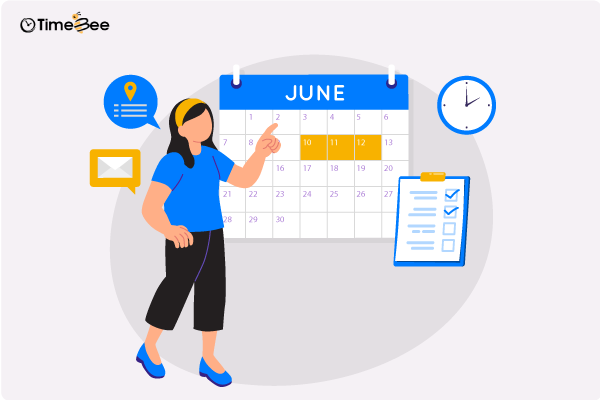Content
Content
Employee productivity is the efficiency and effectiveness with which workers utilize their time, resources, and skills to accomplish goals set by their organization. A productive employee helps boost profits and make the company more organized, competitive, and successful.
For a company, productive employees are valuable assets; however, such individuals are seldom naturally found. Employers’ provision of guidelines, assistance, and benefits cultivate them. Here are eight ways to improve employee productivity.
Ways to Increase Productivity
1. Set Realistic Goals for Employees
Set clear and achievable goals for your employees. Employees who are given clear instructions about what they must achieve are far more productive.
Having a roadmap to achieve a goal and knowing its impact motivates them to improve their jobs, increasing overall performance.
Take time to align the goals and ensure the objectives are communicated thoroughly. Employers follow various practices, including Creating Key Performance Indicators (KPIs). These indicators provide a measurable way to track employee performance and progress toward goals.
Setting KPIs for each employee can establish clear expectations and benchmarks for success. This method helps employees stay focused, allows you to identify areas for improvement, and provides targeted support.
2. Optimize Email and Meetings
Your employees’ time is valuable. So, as an employer, you should focus on strategies to enhance team efficiency.
Employee time is divided into two parts:
i.The productive activities they perform
ii. Communication about the tasks on the job.
Communication is necessary, but if it is prolonged, it becomes a distraction. You can reduce it by optimizing email and meetings.
Emails are crucial for all businesses. They are reliable and professional ways of communicating in the workplace; however, if they are extensive, they could be a better use of time. Studies show that workers spend around 23% of their time on email.
Some studies say they check their email about 36 times per hour. Also, 40% of emails are viewed on mobile devices, which can be distracting.
As evident, extensive emails can take up most of an employee’s time. Keeping all email communication precise and to the point helps everyone out.
Like emails, meetings also take up employees’ time. Optimizing them also increases work time for employees, simultaneously increasing employee productivity. Keep the meeting short and to the point. Pick an agenda, discuss it, and try not to deviate from the primary concern.
3. Invest in Training and Development
For most companies, employee training is only relegated to the first couple of weeks on the job.
However, employee training should not be a one-time event. Most industries opt for quarterly training sessions and programs to update employees with the latest technology and trends.
Investing in training and development gives employees a new perspective, especially those stuck in a monotonous work loop. Introducing innovative technology and solutions intrigues employees and motivates them to achieve goals, increasing their productivity. Also, innovating the job and workplace contributes substantially to employee development.
In addition, training improves employees’ skills and expertise. They consider themselves more valued and do their work more efficiently.
4. Build a Positive Work Environment
The workplace environment is the space and location where workers spend most of their time. It has a direct effect on their mental and physical health and, therefore, on their productivity. Here are a few quick tips to create a healthy work environment for your employees
- Provide ergonomic workstations, such as adjustable chairs and standing desks, to promote proper posture and reduce the risk of musculoskeletal disorders.
- Maximize natural light exposure as it improves mood, energy levels, and overall well-being.
- Improve indoor air quality by ensuring proper ventilation, as it can reduce fatigue and respiratory issues.
- Implement measures to reduce noise levels.
- Maintain a comfortable temperature.
- Wellness Rooms: Create dedicated wellness rooms where employees can take breaks.
- Stock the office kitchen or break room with nutritious snacks and beverages.
- Create walking paths or designate outdoor spaces where employees can take short breaks.
- Install hydration stations equipped with filtered water dispensers.
These factors create a healthy environment where employees can thrive as productive workers.
5. Promote Transparency in Communication
Effective communication is the key to ensuring employees understand their roles, responsibilities, and goals.
Workplace communication includes employers communicating with employees, workers communicating among themselves, and any third-party communication.
For a workplace, all these conversions should be respectful and transparent.
Here is how you can build an effective communication network in your organization.
- Establish clear communication channels for different purposes. Use emails and professional apps to communicate about the work. Make sure you have access to all work-related conversations.
- Encourage active listening between employees and management. Understand your employees’ situations and create an environment where they can freely share their concerns.
- Schedule regular team meetings to discuss projects, address roadblocks, and brainstorm solutions.
With transparent communication channels, you can minimize misunderstandings and promote collaboration, creating a productive environment for your employees.
6. Offer Flexibility and Promote a Healthy Work-Life Balance
Research says that employees who have a healthy work-life balance are more productive.
A healthy work-life balance means employees are happy and productive while having the time for their personal lives. However, sometimes, one aspect requires circumstantial adjustments. Not giving employees leverage over their workload can affect their personal lives.
By offering flexible work arrangements, such as remote work options or flexible hours, you can empower employees to manage their workloads more effectively.
Promoting a healthy work-life balance reduces stress and burnout and enhances employee motivation and productivity.
7. Provide Feedback and Celebrate Achievements

Prompt feedback is essential for guiding employee performance and development. Feedback doesn’t necessarily mean pointing out mistakes and criticizing the work. Appreciating employees for a job well done motivates them to do an even better job and makes them more productive.
In addition to appreciation, you should also celebrate if the employee or a team has achieved a milestone. It can be a reward, an award, or a small party. Verbal praise and written commendations are also forms of recognition that boost confidence in employees.
Mentioning such achievements motivates the rest of the teams as well. Positive reinforcement can boost morale and motivation, driving continued productivity and success.
8. Offer Better Incentives
Incentives are powerful tools for motivating employees and driving productivity. Research shows that constructed incentive programs can increase performance by as much as 44%. The added benefits are a deciding factor when an employee joins and also help retain them. So, employers need to come up with better incentives.
A few of them include;
- Performance-based bonuses:
These are bonuses based on individual or team performance metrics. When employees exceed what they are expected to do, they become eligible for this bonus. - Recognition programs:
Give them monthly or quarterly awards to celebrate employee achievements and contributions. - Career advancement opportunities:
As incentives, offer career growth and advancement opportunities. These could include promotions, moving to different departments or roles, or access to professional development programs. - Profit-sharing or stock options:
Profit-sharing programs or stock options align employees’ interests with the company’s success. This incentive develops a sense of ownership, and the employee automatically becomes more productive to make the project successful.
Boost Employees’ Productivity with TimeBee
Measuring employee productivity is essential because it forms the basis for goals, incentives, and many other decisions about the employee. TimeBee is an employee monitoring tool that helps measure employee productivity in multiple ways. TimeBee allows employees to see their current working status and motivates them to improve.
Here’s how TimeBee can help employers achieve this goal:
Streamlining Workflows
TimeBee helps with task management, project tracking, and time tracking. It tracks employees’ time on a particular task or project, ensuring they are aligned with project goals and deadlines. This feature helps employees work more efficiently and focus on high-priority tasks, ultimately boosting productivity.
Tracking Performance
With TimeBee’s reporting and analytics capabilities, you can track employee performance and identify areas for improvement. It also measures employee performance daily, weekly, monthly, and quarterly. With this data, you can address productivity issues and provide targeted support to employees struggling to meet expectations.
Optimizing Resource Allocation
TimeBee allows employers to allocate resources based on data and insights. You can monitor employee workloads and project timelines, identify bottlenecks, and revise strategies to boost productivity.
By providing real-time data and accurate performance measures of an employee, TimeBee empowers employers to make informed decisions. Moreover, it can help you identify opportunities for improvement in an employee’s performance. To get deep insights into employee productivity and make informed decisions, get TimeBee today!
Wrapping Up
By implementing the above strategies, you can empower your employees, improve communication and collaboration, and cultivate a culture of continuous learning with the proper guidance and a suitable environment.
It is important to remember that increases in employee productivity and, hence, their performance do not happen overnight. It is the result of consistent efforts and implementation of sound policy. These policies should always prioritize the health and well-being of your employees
When employees are productive, they are less likely to get bored and will strive to make the business more successful.
Need a Fast Way to Increase Employee productivity?
Check out TimeBee
Similar Reading



